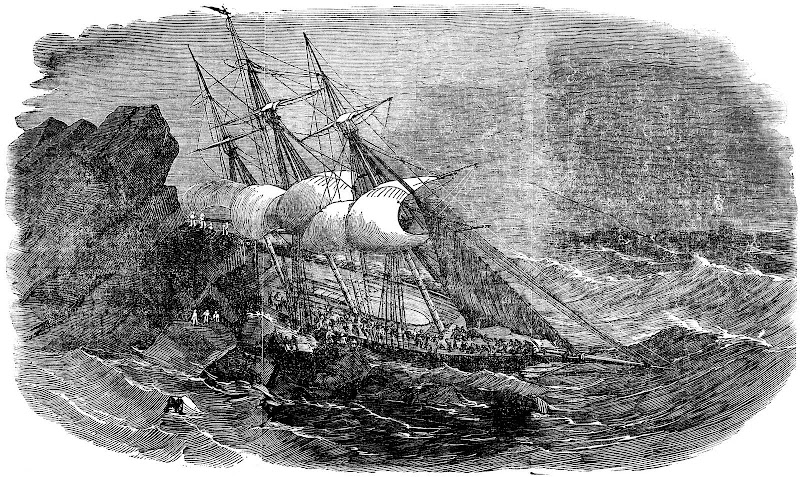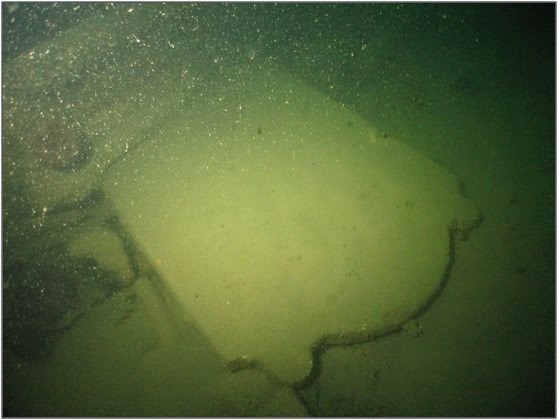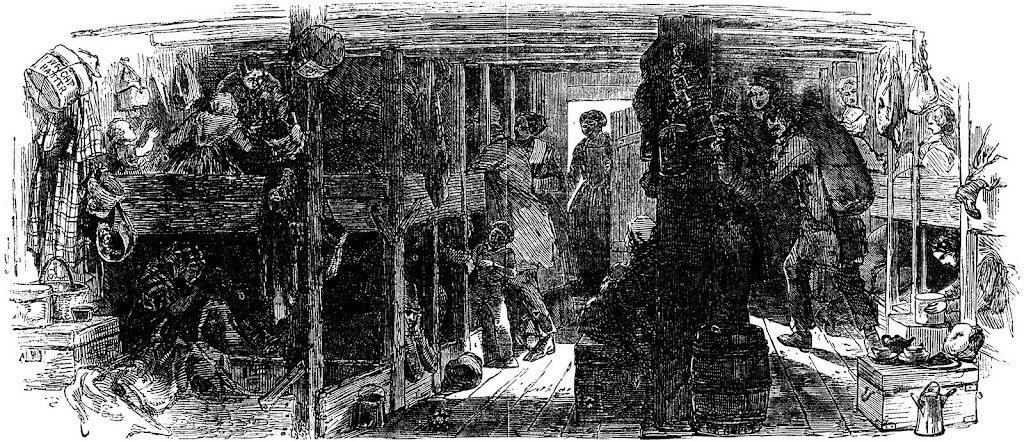Shipwreck in Ireland: The Sinking of the RMS Tayleur
Sometimes a book grabs you by the heart and won't let go. Such is the case of an extraordinary new book by UK author Gill Hoffs, entitled The Sinking of the RMS Tayleur: The Lost Story of the 'Victorian Titanic'. I have to tell you: I started reading, and couldn't put it down. This story is so well-written that while I was reading, I felt the chills of the brisk winds and rain, imagined the splash of seawater on my face, and heard the frightened cries of hundreds as they tried to escape a sinking ship, avoid getting dashed on jagged rocks, and scale a steep rocky cliff to safety. It's that good.

RMS Tayleur wrecking on Lambay Island, Ireland
When history comes alive, it can shock and astonish. Such is the case that Hoff has penned - that of the RMS Tayleur, an 'unsinkable' ship, much like its fellow White Star Line ship, the Titanic. Leaving the UK for Australia, the Tayleur carried hundreds of passengers and crew. It was an untested new ship (with many flaws, as history shows), and didn't even make it past Ireland before wrecking in a horrible storm. Most of the people on board died, including almost all of the women and children. In this book, Hoffs sensitively tells the tales of many people on board, including passengers, crew, the doctor, and captain. Through exhaustive research and original sources, Hoffs has managed to dive back into history to Lambay Island, Ireland, and revive this forgotten chapter in history, bringing it vividly to life. And that's the mark of a great writer - to tell such a tale, and make the reader care. I DO care, and this story will stay with me forever. I highly recommend it to our Wandering Educators.

We were lucky enough to catch up with Gill, and learn about the backstory of the book, her inspiration, research, Nutella, visiting Lambay Island, and more. Here's what she had to say...
Please tell us about your book, The Sinking of RMS Tayleur...
The Sinking of RMS Tayleur: The Lost Story of the 'Victorian Titanic' is the (unfortunately) true tale of a horrific shipwreck off the coast of Dublin 160 years ago, where almost all of the women and children died along with over half of the men despite the ship being so close to land that the first survivors jumped to safety. Run by the White Star Line, the revolutionary design promised safety and luxury to the 650+ emigrants leaving Liverpool for the Australian Gold Rush, but sank 48 hours into her maiden voyage when the ship rammed the cliff of an island "rising like a mountain from the sea." My book focuses on the people involved, why they were leaving home or seeking a new one, and how they were affected by the shipwreck if they survived. It also contains the most comprehensive passenger/crew list yet so do check at the back to see if your family's involved (and email me at gillhoffs[at]hotmail.co.uk if they are!).

What inspired you to write this book?
A visit to my local museum in Warrington in the north-west of England, where a curator told me about a little collection of shipwreck artefacts they had on display. Warrington is an inland town on the River Mersey, roughly midway between Manchester and Liverpool, and to learn it had a major ship-building industry, and made what was the biggest vessel of her class in the world at that time, was quite something. He advised me to read the survivor accounts, so I did and ended up sobbing over the computer keyboard. They were truly horrific, detailed and destroying, and I swore I wouldn't read anything else about it ever EVER again. But those last grim moments of children, parents, and siblings really took root in my mind. I started posting about my research online, a friend on facebook sent me a link to a call for submissions from Pen and Sword and, well, this is the result. Most of those lost in the wreck have no official grave or memorial, though in an eerie coincidence, part of the cargo the Tayleur was carrying included blank gravestones which now lie like tumbled dominos on the seabed, so my hope is that this book will act as some kind of memorial now.

Underwater gravestone. Photo Eoghan Kieran
I'm all about the research - what were your biggest challenges in researching this book?
Oh, there was a whopper I really struggled with at the start. One of the men I focus on in the book, an ex-convict from Lincolnshire who was transported to Tasmania as a young man then returned to England with a fortune from the Australian Gold Rush in search of his lost love and young son, had the wrong surname in the first reports I looked at, which is understandable given how easy it is to misread hurriedly written notes (something I'm guilty of myself, *ahem*). So I spent quite a while looking for a "Samuel Carley" when really he was "Carby", and only found out when I typed in the name of the place where he was sentenced in a last ditch attempt to navigate an Australian convict-ship site. Once I signed up to Ancestry and the British Newspaper Archive, and got used to Trove, I was fine, and I would absolutely recommend using them if you are researching a particular period, person, or place. Riveting stuff!

Below deck on an emigrant ship

Death is the poor man's friend
You also write about talking with descendants of survivors - how was that experience? (I assume bittersweet, since there were so few.)
Definitely bittersweet! 160 years sounds a tremendous amount of time, but it's really only a few generations ago. I've been in contact with the granddaughter of one of the children who survived, and this was an incredible thrill. As with many of the people I got in touch with, she had been unaware of her ancestor's involvement with this generally forgotten tragedy, and to read her letter and meet with her son and his wife to place flowers on their ancestor's grave was very satisfying. I felt like I'd helped close a circuit aching to be fixed. One man I talked with was almost in tears as I told him of his ancestor's heroism. Some of my phone calls and emails have left the recipients with lots of questions but many have clarified old relationships or filled in gaps in family trees, and I'm very grateful for the help I've been given.
Retracing the final moments of the Tayleur on Lambay Island, Ireland
Looking toward the cliffs where people clung to safety in a storm
You recently visited Lambay Island, and read aloud the names of the people from the Tayleur. I just love that, and imagine it was such a powerful moment. What was it like, writing sensitively about such a horrific shipwreck?
Fattening! There's a German word for the weight gained from emotional over-eating, "kummerspeck", and Nutella is mentioned in my Acknowledgments section for this very reason. It was emotionally draining and I was very aware of my responsibility in recording the last moments and lives of the poor sods who just wanted a chance at a better life for themselves and their loved ones, and have largely been forgotten now even by their families and places of origin, which feels very wrong to me. The story of the Tayleur is quite emblematic of the struggles and dangers faced by many thousands of people who took to sea then and now, and it was so important to do them justice and tell their story as correctly as possible - and to really try to make readers feel the loss of the victims emotionally, instead of as a figure on a page, and remember them once they put the book down. I initially hoped that in writing of their ordeal I'd somehow exorcize their plight from my mind - after all, it's not like I can do anything to help them now, so it makes no sense to be this upset over something so long ago - but if anything it's embedded them more permanently in my memory. My trip to Lambay and the reading of the names on the cliff top was something I'd hoped to do when I first started writing my book, and the time it took to read every single name aloud really brought home to me how many people were involved in the collision that day.
Top of the cliffs at Lambay, looking toward the wreck site
Too often, we see museums as full of dusty relics, and forget that each item in there has such a rich history. How do you suggest travellers dig into local history?
Visit any local museums you encounter on your travels, especially the smaller, dustier ones. They are the ones I love best, they seem far more appealing than the futuristic places with brightly-lit glass cases with only a couple of near-sterile items inside. The museums that appear almost derelict from outside - I have particularly fond memories of one in Glencoe - with quirky curators and crammed exhibits - are far more entertaining and informative. Ask the people who work there about whatever takes your fancy, or if there's anything in the area or in storage related to your particular interests, and if you stop for lunch or a snack, ask the people there, too. Pubs and independently-run cafes can be goldmines for this, and if you're staying somewhere for a while do see if there's a local history group who might accept your phone call or answer your emails and perhaps even show you round. History departments in the universities and colleges of larger towns and cities are worth contacting in advance too. I find that generally if you're enthusiastic and polite you'll find what you need somehow. People like to share a passion.
Tayleur porthole, Warrington Museum
What's up next for you?
Preparation for talks at bookshops and history groups, some guest-editing for Chicago-based online literary journal Literary Orphans, and binge reading the teetering piles of books that have built up while I worked. I also have a maritime thriller (fiction this time) currently out with agents - so do keep your fingers crossed for me! - and when I'm not taking my seven-year-old to school and back or picking twigs out of his hair I'm researching the Mary Celeste for another thriller and keeping an eye out for mention of other shipwrecks to write about. There are some special events to do with the Tayleur next year which I'll be talking about on twitter (@GillHoffs) and at http://gillhoffs.wordpress.com/ closer to the time, and I'm sure I'm due a long lie sometime before Christmas, too! That's if my cat, Coraline, and son agree...
Is there anything else you'd like to share with us?
I am in permanent need of chocolate, marzipan, jokes, and recommendations of particularly interesting shipwrecks. And I'm naturally light-hearted and irreverent, though my subject matter would usually suggest otherwise.
All photos courtesy Gill Hoffs
Note: We received a review copy of The Sinking of the RMS Tayleur: The Lost Story of the 'Victorian Titanic' from the publisher - thank you!
A visit to a museum spurred research and the writing of a book on the RMS Tayleur, wrecked in Ireland in 1854. Interview with author Gill Hoffs
Posted by: Jessica Voigts





















